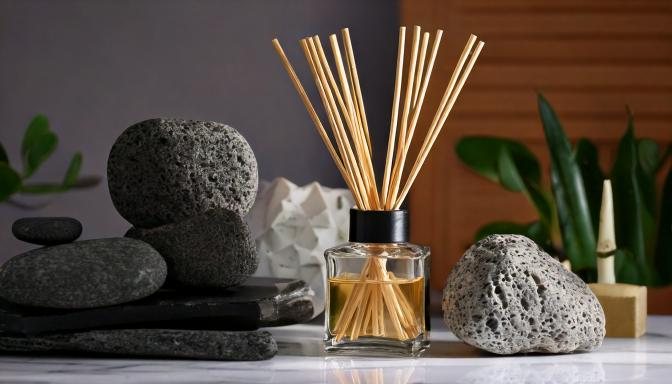
Passive fragrance diffusion is a versatile, low-maintenance way to scent your space. With options like reeds for steady diffusion, lava rock for subtle and lasting aroma, and plaster for decorative applications, there’s a solution for every need and style.
Passive fragrance diffusion is a way to release scent into the air without using heat, electricity, or fans. It relies on materials like reeds, lava rock, plaster, or wood to absorb fragrance oils and naturally evaporate them over time.
Reeds: Rattan reeds wick oil from a container and release the scent into the air.
Lava Rock: Porous volcanic rock absorbs and gradually releases fragrance.
Plaster or Gypsum: Decorative materials that hold oil well and provide balanced scent throw.
Terracotta or Ceramic: Aesthetic options that diffuse fragrance slowly.
Wood: Eco-friendly and natural, offering subtle scent diffusion.
Fabric or Felt: Lightweight, portable, and suitable for short-term use.
Paperboard or Cardstock: Common in disposable air fresheners.
Bamboo Charcoal: Absorbs fragrance while also reducing odors.
Concrete: Modern and durable with slow, steady diffusion.
The performance of passive diffusion materials varies based on their properties:
Reeds offer moderate scent throw and typically last 4–8 weeks, making them ideal for small to medium spaces. They need regular flipping to maintain effectiveness.
Lava Rock provides a subtle and long-lasting scent. Its porous nature allows it to diffuse fragrance over weeks, making it suitable for smaller areas.
Plaster and Gypsum are decorative options that hold oil well and provide a balanced scent throw. They typically last 1–2 weeks before needing reapplication.
Terracotta and Ceramic are aesthetic choices with slow, steady scent diffusion. They last for weeks and work well in rustic or visually appealing settings.
Wood offers a natural and eco-friendly option with gentle scent release that lasts for weeks, complementing minimalist or organic designs.
Fabric or Felt absorbs oil quickly, providing a strong but short-lived scent. These materials are best for portable or temporary scenting, lasting a few days per application.
Paperboard or Cardstock delivers a strong scent initially but is short-lived, making it ideal for disposable air fresheners.
Bamboo Charcoal serves as both a deodorizer and a subtle diffuser, lasting for weeks in enclosed spaces.
Concrete provides a modern aesthetic and releases fragrance slowly over weeks, making it suitable for decorative and contemporary designs.
Each material has unique strengths, so choose based on your preferred scent intensity, longevity, and aesthetic appeal.
Reeds use capillary action to draw fragrance oil from a container, releasing the scent as the oil evaporates from the surface of the reeds. They are ideal for consistent, low-maintenance scenting in small to medium spaces.
Lava rock absorbs and releases oil more slowly than reeds, offering subtle, long-lasting scent diffusion.
Reeds provide a stronger scent throw but need periodic flipping and replacement to maintain performance.
Energy-Free: No need for electricity or heat.
Customizable: A wide range of materials and designs to fit your style.
Eco-Friendly: Many materials, like wood and lava rock, are biodegradable or reusable.
Safe: No open flames or heat sources, making them family- and pet-friendly.
Reeds: 4–8 weeks.
Lava Rock: Several weeks, with reapplication as needed.
Plaster: 1–2 weeks per application.
Fabric/Felt: 2–3 days for portable use.
Reapplication of oil extends the lifespan.
Reeds: Replace every 2–4 weeks, as they can clog with oil.
Lava Rock: Rinse with warm water, let dry completely, and reapply oil.
Plaster/Ceramic: Clean gently with a damp cloth or replace when no longer effective.
Fabric/Felt: Wash or discard depending on the application.
Place in areas with moderate airflow to promote scent diffusion.
Avoid direct sunlight or heat, which can cause oils to evaporate too quickly.
Ideal locations include bedrooms, bathrooms, entryways, or desks.
Increase scent throw by using more reeds, flipping reeds more often, or adding more oil to materials like plaster or lava rock.
Reduce intensity by using fewer reeds or placing the diffuser in a larger, more ventilated space.
Yes! Passive diffusers are generally safe when used properly. To ensure safety:
Avoid over-saturating materials to prevent spills.
Keep diffusers out of reach of children and pets.
Use oils specifically designed for home fragrance.
Written by Tony Bierman
Tony Bierman co-founded Candlecopia, a home fragrance company, in 2009. In addition to being a 15-year veteran of the home fragrance industry, Tony is also an author, an award-winning software developer, and an amateur photographer. In his spare time, you’ll find him hiking the woods of Roanoke Creek, with his camera and his dogs.
